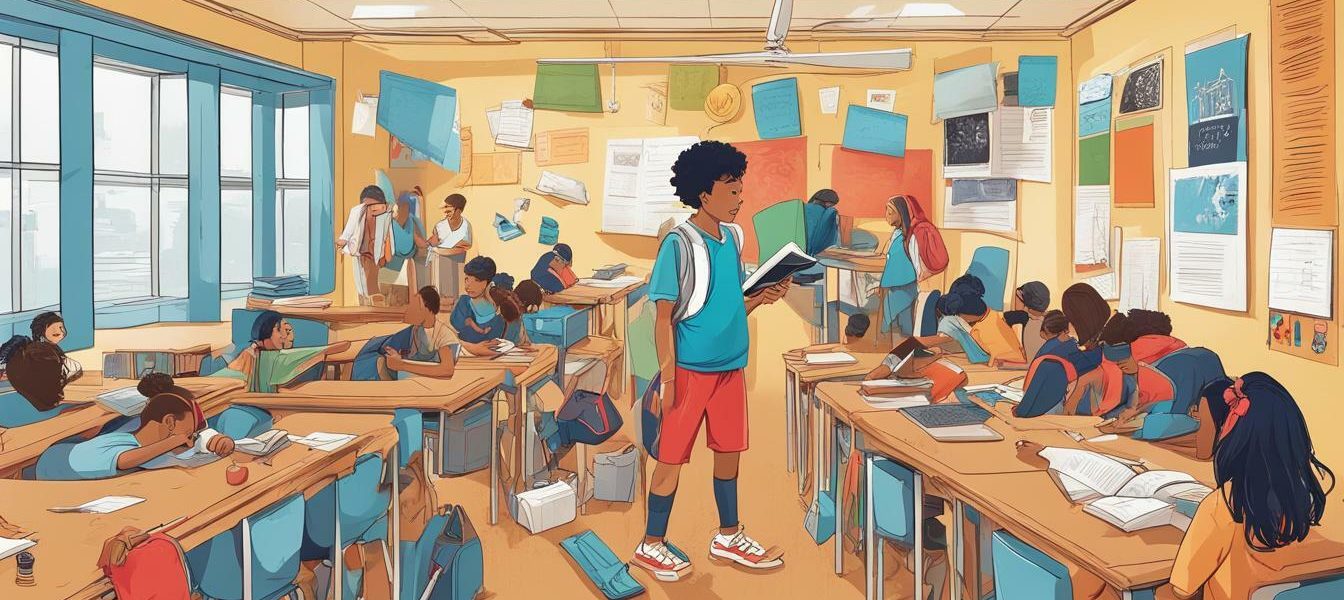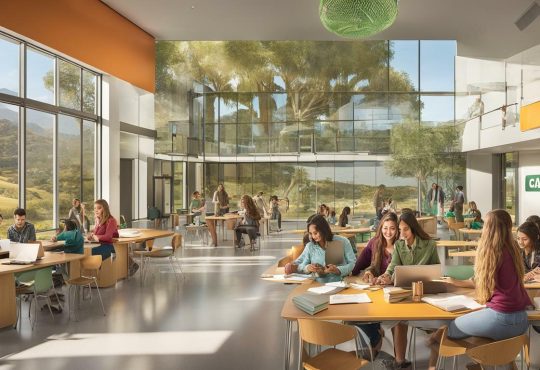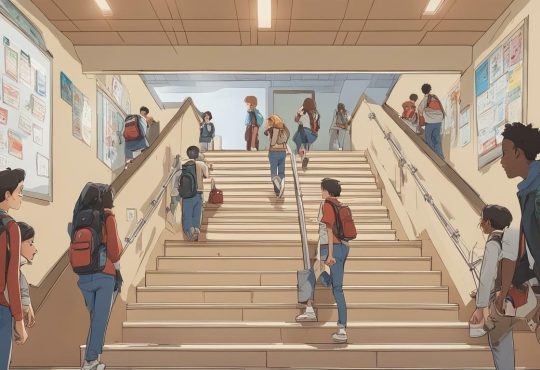
Why Is School So Boring?
Have you ever found yourself sitting in a classroom, staring at the clock, waiting for the day to be over? Many students can relate to this feeling of boredom in school. It’s a common perception that school is tedious, bland, and uneventful. But why is this the case?
There are various reasons why school can be perceived as boring. It could be due to the lack of student engagement, traditional teaching methods, or the failure to connect learning with real-world experiences. Whatever the reason, it’s clear that this issue needs to be addressed to provide students with a more engaging educational experience.
Key Takeaways
- Student motivation is key to overcoming boredom in the school system.
- Traditional teaching methods may limit student engagement and require more innovative approaches.
- Relevance in education and real-world connections can make learning more interesting.
- The classroom environment and teacher-student relationships can greatly impact student engagement.
- Excessive emphasis on testing and grades can negatively affect student motivation.
- Student-centric learning approaches and personalized experiences can enhance engagement.
- Technology and the arts can be effectively integrated into the curriculum to make learning more interactive and exciting.
- Addressing different learning styles and interests is crucial for personalized learning experiences.
- Involving parents and the community in education can contribute to a more engaging school experience.
- Implementing changes and taking action can enhance student engagement and make school less boring.
Understanding Student Motivation
One of the main reasons why school can be boring for students is the lack of motivation they feel. Without a sense of purpose or interest, students can easily become disengaged and uninterested in the learning process. To combat this issue, educators must understand what drives student motivation and how to increase it.
Reasons for Boredom in the School System
There are various reasons why students might feel bored in school. For some, the material might be irrelevant or uninteresting. For others, the classroom environment might not be stimulating or engaging enough. Additionally, traditional teaching methods that rely heavily on lectures and memorization can be tedious and unengaging for students.
Tips to Improve School Motivation
To combat these issues and increase student motivation, educators should consider implementing the following strategies:
- Make learning relevant: Incorporate real-world examples and connections to show students how the material they are learning is applicable to their lives.
- Create a stimulating learning environment: Use interactive activities, group work, and project-based learning to encourage student engagement.
- Personalize the learning experience: Cater to different learning styles and individual interests to make learning more meaningful for each student.
- Provide frequent feedback: Offer feedback that is specific, constructive, and timely to help students track their progress and stay motivated.
- Make learning fun: Incorporate games, challenges, and other activities that make learning enjoyable and rewarding.
By implementing these strategies, educators can create a more engaging and motivating learning experience for students. When students feel invested in their education and have a sense of purpose, they are more likely to be successful and find fulfillment in their academic pursuits.
The Impact of Traditional Teaching Methods
Traditional teaching methods, which are based on rote memorization and passive learning, have long been criticized for their limited effectiveness in engaging students and promoting active learning. While traditional approaches certainly have their place in education, it is important to recognize their limitations and consider alternative, more innovative methods that can help make learning more stimulating and exciting.
One of the major problems with traditional teaching methods is that they do not take into account the diversity of learning styles and preferences among students. Many students simply do not learn well through passive listening and memorization, and may instead benefit from more interactive, hands-on approaches to learning. By utilizing more diverse teaching methods, such as project-based learning or collaborative learning, educators can better cater to the individual needs and preferences of their students, creating a more engaging and stimulating learning environment.
The Benefits of Interactive Learning
Interactive learning, which emphasizes active participation and engagement, has been shown to have a positive impact on student motivation and learning outcomes. By incorporating elements such as group work, peer reviews, and problem-solving exercises into the curriculum, students are encouraged to take an active role in their own learning, which can help deepen their understanding and increase their motivation to learn.
In addition, interactive learning can help promote important skills such as critical thinking, communication, and collaboration, which are essential for success both in and outside of school. By creating opportunities for students to engage with complex problems and work with others to find solutions, educators can help prepare them for the challenges they will face in the real world.
The Need for Innovation
While traditional teaching methods have their place, it is clear that they are not enough on their own to engage all students and promote active learning. In order to create a truly stimulating and exciting learning environment, educators must be willing to explore new, more innovative approaches to teaching and learning.
One way to do this is by incorporating technology into the classroom, which can help create more interactive and personalized learning experiences. For example, using educational apps or interactive whiteboards can help engage students and promote active learning. Additionally, educators can also consider incorporating more creative and artistic elements into the curriculum, such as music, drama, or visual art, which can help stimulate students’ imaginations and promote deeper engagement with the material.
Ultimately, the key to overcoming the limitations of traditional teaching methods is to remain open-minded and willing to experiment with new approaches. By embracing innovation and focusing on creating a stimulating and exciting learning environment, educators can help ensure that all students are engaged, motivated, and eager to learn.
The Impact of Traditional Teaching Methods
Traditional teaching methods often prioritize rote memorization and passive learning, which can contribute to student boredom and disengagement. Lectures, worksheets, and standardized tests may only scratch the surface of a topic, leaving students uninterested and lacking in-depth knowledge.
Moreover, traditional teaching methods tend to treat all students the same way, regardless of their learning style or interests. This one-size-fits-all approach fails to recognize that students learn differently and have unique strengths and weaknesses. Students who struggle to keep up may become further disengaged and discouraged, while those who find the material easy may feel unchallenged or bored.
To overcome the limitations of traditional teaching methods, educators must adopt more innovative approaches that prioritize student engagement and active learning. By incorporating technology, personalized learning experiences, and creativity into the curriculum, educators can create a more stimulating learning environment that caters to the diverse needs and interests of students.
Classroom Environment and Teacher-Student Relationship
A positive classroom environment can greatly impact student engagement and motivation. When students feel safe, respected, and valued for their contributions, they are more likely to participate actively in class and take ownership of their learning. Teachers can create this kind of environment by fostering a sense of community in their classroom and promoting open communication.
Building strong teacher-student relationships is also key to overcoming school boredom. When students have a positive relationship with their teacher, they are more likely to trust them and feel comfortable asking for help or expressing their opinions. Teachers can cultivate these relationships by getting to know their students on a personal level and demonstrating genuine care for their well-being.
Furthermore, teachers can make learning more stimulating and engaging by incorporating a variety of teaching strategies that cater to different learning styles. By using visual aids, hands-on activities, and group projects, for example, teachers can create a more dynamic and interactive learning environment that keeps students engaged and motivated to learn.
“Creating a positive classroom environment requires effort, but it pays off in terms of student engagement and motivation,” says veteran teacher Ms. Smith. “When students feel valued and supported, they are more likely to take risks and challenge themselves academically.”
Overemphasis on Testing and Grades
Excessive focus on testing and grades is identified as another major contributor to school boredom. Rather than promoting active learning and encouraging students to engage with the material, traditional assessment methods can lead to a narrow view of education and a lack of interest in the subject matter.
Students are often more concerned with achieving high grades rather than truly understanding the content, which can result in surface-level learning that fails to inspire a deeper curiosity. The emphasis on memorization for the sake of testing can also be alienating for students who prefer to learn through other methods.
To combat this, alternative methods of assessment that promote active learning should be adopted. Performance-based assessments, such as projects or presentations, can be more engaging for students and help them to develop practical skills that are relevant to the real world. These assessments can also be more inclusive, as they allow students with different learning styles and strengths to demonstrate their knowledge and understanding in a way that suits them best.
Moreover, teachers should communicate the purpose of assessments better and provide meaningful feedback that encourages students to learn from their mistakes and improve. The use of grades should be balanced with qualitative feedback that highlights areas of strength and areas for improvement.
By taking a more holistic approach to assessment, schools can promote active learning and encourage deeper engagement with the material, ultimately reducing boredom and increasing student motivation.
The Lack of Student-Centric Learning Approaches
Traditional teaching methods often focus on a one-size-fits-all approach, disregarding individual learning styles and interests. This can lead to disengagement and a lack of motivation among students.
Fortunately, there are innovative approaches that can enhance student engagement and create a more stimulating learning environment. One such approach is student-centric learning, which puts the needs and interests of the student at the forefront of the education process.
By allowing students to have a say in what they want to learn and how they want to learn, they are more likely to feel invested in their education and take an active role in their own learning journey.
Examples of student-centric learning include project-based learning, where students work on long-term projects that incorporate various subjects and allow for creativity, and gamification, where educational content is presented in a game-like format, making it more engaging and interactive.
Incorporating Technology in the Classroom
One way to make school less boring is to incorporate technology into the classroom. By doing so, teachers can make learning more interactive, engaging, and exciting. With technology, students can access a wealth of resources and information that would otherwise be unavailable to them.
There are several ways technology can be integrated into the classroom. For example, teachers can use presentation tools, such as PowerPoint or Prezi, to create visually appealing lessons. They can also use online tools to create interactive quizzes or games that help reinforce concepts.
Another way technology can be used in the classroom is through virtual field trips. By using virtual reality technology, students can visit different parts of the world without leaving the classroom. This allows them to explore new cultures and experiences that they may not have had the opportunity to otherwise.
Using Technology to Enhance Student Collaboration
Technology can also be used to enhance student collaboration. With online tools like Google Docs or Padlet, students can work together in real-time to create projects or brainstorm ideas. They can also use online discussion forums to share their thoughts and opinions on different topics.
However, it is important to remember that technology should not replace traditional teaching methods entirely. Instead, it should be used as a supplement to enhance the learning experience. Teachers should also ensure that all students have access to technology and that it is used in an appropriate and responsible manner.
The Role of Creativity and Arts in Education
The incorporation of creativity and arts in education has been found to be beneficial in enhancing student engagement and making learning more interesting. Studies have shown that students who are exposed to the arts tend to perform better academically and have higher levels of motivation and self-esteem.
Art and creativity help students develop critical thinking and problem-solving skills while also fostering their imagination, curiosity, and emotional intelligence. By creating a stimulating learning environment that integrates artistic expression, educators can encourage students to explore their individuality and interests.
There are various ways to incorporate creativity and arts into education. For example, teachers can encourage students to express themselves through art projects, music, theater, and writing. Additionally, schools can partner with local artists and organizations to provide students with access to cultural events and workshops.
For instance, an art club could be created where students have the opportunity to display their talents, while also learning new techniques from an art teacher. Additionally, a school assembly could be organized where students can showcase their artistic talents to their peers.
Overall, incorporating creativity and arts in education can create a more engaging and exciting learning experience for students. It’s vital to recognize the role of creativity in education and prioritize its integration into the curriculum to cater to the needs of students and promote their academic success.
Addressing Student Individuality and Different Learning Styles
Every student is unique, with distinct learning styles and preferences. Addressing these differences is essential to create a truly engaging learning environment. Educators must be aware of the various learning styles, such as visual, auditory, and kinesthetic, and incorporate a variety of teaching methods that cater to each of these preferences. This can include using visual aids, interactive activities, and hands-on experiences that allow students to engage with the material in ways that suit their learning style.
One effective approach is using a personalized learning approach that focuses on the individual needs and goals of each student. This allows educators to tailor the learning experience to the specific interests and needs of the student, which can improve engagement and motivation. Additionally, providing ample opportunities for student-led projects and group work can help students develop crucial collaborative and problem-solving skills, while also encouraging active participation and engagement in the learning process.
Recognizing and addressing student individuality is also crucial to ensuring that students feel heard and valued in the classroom. By creating a positive and inclusive learning environment that celebrates diversity, educators can foster a sense of belonging and engagement among all students. This can include incorporating diverse perspectives and experiences into the curriculum, and providing meaningful opportunities for students to share their own experiences and perspectives.
Ultimately, by embracing student individuality and catering to different learning styles and preferences, educators can create more engaging and effective learning experiences that empower students to reach their full potential.
The Role of Parent and Community Involvement in Creating an Engaging School Experience
Parent and community involvement is crucial in creating an engaging school experience for students. When parents are involved in their child’s education, it helps to foster a positive and supportive learning environment. Community involvement can also provide students with a sense of belonging and connection to their community, which can enhance their motivation to learn.
There are many ways that parents and community members can get involved in their local schools. Some examples include:
- Volunteering in the classroom or at school events
- Attending parent-teacher conferences and school board meetings
- Participating in school fundraisers or donating school supplies
- Mentoring or tutoring students
- Collaborating with teachers on special projects or extracurricular activities
By working together with educators, parents and community members can help to create a more engaging and stimulating learning environment for students. This can lead to improved academic achievement, as well as increased motivation and enthusiasm for learning.
“When parents are engaged in their child’s education, it helps to foster a positive and supportive learning environment.”
Benefits of Parent and Community Involvement
Research has shown that there are numerous benefits to parent and community involvement in education. For example:
- Improved academic achievement: When parents and community members are involved in education, students tend to have higher grades, better attendance, and improved behavior in the classroom.
- Increased motivation: When students feel that their parents and community members are invested in their education, it can increase their motivation to learn.
- Greater sense of community: When parents and community members are involved in their local schools, it can help to create a sense of community and connectedness among students, families, and educators.
- Enhanced communication: When parents and community members are involved in education, it can improve communication between schools and families, leading to better support for students.
“Research has shown that there are numerous benefits to parent and community involvement in education.”
How to Get Involved
If you are a parent or community member who is interested in getting involved in your local schools, there are many ways to do so. Some tips include:
- Attend school events and activities: This can help you to stay informed about what is happening in the school, as well as provide opportunities to connect with educators and other families.
- Join the PTA or other school committees: This can provide opportunities to have input on decision-making and help to plan events and activities.
- Volunteer in the classroom or at school events: This can help to support educators and provide students with additional resources and support.
- Advocate for education funding and policy: This can help to ensure that schools have the resources they need to provide a quality education to all students.
By getting involved in your local schools, you can help to create a more engaging and supportive learning environment for students. Whether you are a parent, community member, or educator, your involvement can make a positive impact on the lives of students.
“By working together with educators, parents and community members can help to create a more engaging and stimulating learning environment for students.”
Implementing Changes for a More Engaging Education
After exploring the various reasons why school can be boring for students, it’s important to take action and implement changes that enhance student engagement and make learning more exciting. Here are some actionable steps that schools and educators can take:
1. Incorporate more student-centered learning approaches
One of the most effective ways to combat school boredom is by incorporating student-centered learning approaches. This means placing the focus on the student’s interests and needs, and allowing them to take an active role in their learning. Teachers can achieve this by using project-based learning, gamification, and other interactive approaches that allow students to learn by doing.
2. Create a more stimulating learning environment
The classroom environment plays a crucial role in student motivation and engagement. To make learning more interesting, educators can incorporate elements of fun and creativity in their teaching methods. This can include using visual aids, incorporating music and movement in lessons, and creating a comfortable and welcoming classroom.
3. Personalize learning experiences
All students have different learning styles and preferences. To cater to them, educators can personalize learning experiences based on individual interests and needs. Teachers can achieve this by offering students different ways to demonstrate their learning, such as through presentations, essays, or videos, and by providing opportunities for student choice in assignments and projects.
4. Introduce more technology in the classroom
Technology can be a valuable tool in making learning more interactive and exciting. Educators can use educational apps, videos, and games to supplement their lessons and enhance student engagement. Additionally, incorporating technology can help students develop important digital skills that will be valuable in their future careers.
5. Collaborate with parents and the community
Involving parents and community members in the education process can have a positive impact on student engagement and motivation. Educators can invite parents to participate in classroom activities, such as guest speakers or field trips, and create opportunities for community members to share their expertise with students. This collaborative approach can make learning more relevant and interesting for students.
By implementing these strategies, schools and educators can create a more engaging and meaningful learning experience for students. It’s important to remember that every student is unique and may require different approaches to stay motivated and interested in their education. By taking a student-centered approach, educators can help students reach their full potential and develop a lifelong love of learning.



